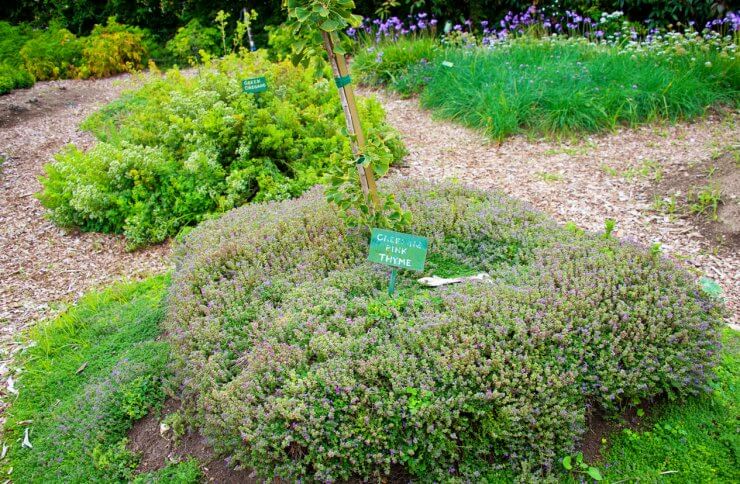
Check even a healthy bed of thyme for signs of sickness
Thyme plants resist disease well, but, like any plant they can become vulnerable to bacteria, fungi, and viruses. Typically, the diseases that affect thyme most often are root rot (Rhizoctonia), grey mold (Botrytis cinerea), and Alternaria blight (Alternaria brassicicola).
Plant diseases can spread through the soil, water, air, infected tools, animals, and even gardeners themselves.
Spot diseases on your thyme plants sooner so you can treat plants before they are destroyed by disease and can successfully manage symptoms. Here is a three-step approach to keeping vigilant about the presence of thyme plant diseases:
- Research the Risks. Find out about thyme diseases that are prevalent in your geographic area. Thyme dislikes humidity, so if you live in zone 10 or 11 or otherwise have a humid growing environment, you’ll have to be more vigilant. Some thyme varieties do better in humid weather than most, so be sure to look for those if your climate is humid or damp.
- Examine Plants Daily. Check your thyme plants every day to be sure no disease symptoms are present or emerging.
- Spot Diseases Early. Catch and treat disease quickly so your plants can recover and thrive.
Thyme diseases can affect the foliage, stems, and roots. Here is what to look for to spot possible infection:
Thyme leaves—possible disease symptoms:
- wilt
- brown color
- yellowing
- brown or black spots with concentric rings
- holes
Thyme stems—possible disease symptoms:
- gray ‘fur’
- dieback
Thyme roots—possible disease symptoms:
- mushy roots
- dieback
Make your own natural disease and pest control spray with benign materials. Mix one tablespoon of baking soda, 1/2 teaspoon of a mild dish detergent, and 2 1/2 tablespoons of olive oil in a gallon of water to make a solution that will repel all kinds of bugs, as well as a fungicide for blight and mildew on the thyme plant leaves. Shake it well in your bottle before spraying and repeat every week for it to be continuously effective.
We’re believers in not using toxic materials in the garden—they can hurt the plants, hurt the soil, damage the environment, and harm you.
Preventive measures to avoid thyme plant diseases
Try some of these techniques for avoiding thyme diseases in the first place:
Choose planting location carefully
Plant thyme in a sunny location and allow at least 10 to 12 inches between plants for a healthy amount of air circulation.
Improve your soil composition

Thyme in poor soil
Thyme thrives on poor soil and it hates wet feet: dense, moist soil can promote root rot. Be sure to amend your soil with sand or perlite, loam, and a bit of organic matter to ensure sufficient drainage. Sandy soil and good aeration help grow stronger plants that will resist disease and infection.
Water your garden properly
Don’t overwater your thyme plants. Thyme is drought-tolerant, so always err on the side of fewer waterings and wait until the soil dries out in your garden or containers before watering thyme. When watering thyme in containers, allow plenty of drainage and don’t let the pot sit in excess water afterward. Overwatering and watering directly on the plants—instead of the preferred watering method, directly at the stem on the soil—leads to consistently wet conditions. This allows bacteria, fungi, and viruses to thrive and multiply.
Destroy infected plants
Throw away or burn infected plants. Don’t keep infected plants over the winter in your garden, and don’t throw them on your compost pile. Disease-ridden plants, even when dead, will spread the disease to other plants or even your soil.
Have you had problems with diseases attacking your thyme plants? What types of problems do you regularly face with your thyme plant? Please tell us how you treat and prevent diseases from destroying your thyme crop.


 Previous
Previous

